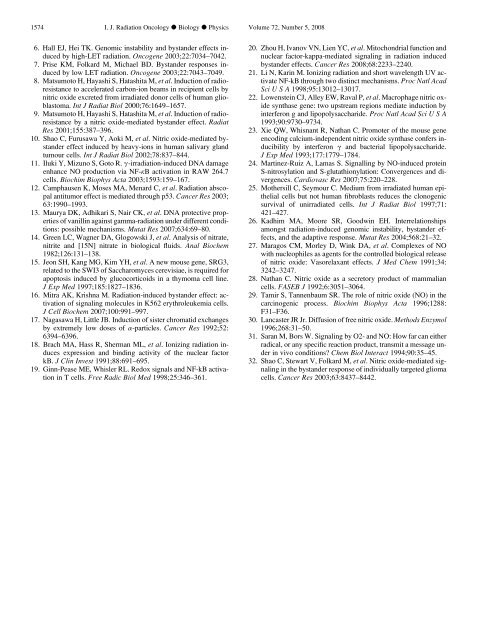LIFE01200604005 Shri Somnath Ghosh - Homi Bhabha National ...
LIFE01200604005 Shri Somnath Ghosh - Homi Bhabha National ...
LIFE01200604005 Shri Somnath Ghosh - Homi Bhabha National ...
You also want an ePaper? Increase the reach of your titles
YUMPU automatically turns print PDFs into web optimized ePapers that Google loves.
1574 I. J. Radiation Oncology d Biology d Physics Volume 72, Number 5, 2008<br />
6. Hall EJ, Hei TK. Genomic instability and bystander effects induced<br />
by high-LET radiation. Oncogene 2003;22:7034–7042.<br />
7. Prise KM, Folkard M, Michael BD. Bystander responses induced<br />
by low LET radiation. Oncogene 2003;22:7043–7049.<br />
8. Matsumoto H, Hayashi S, Hatashita M, et al. Induction of radioresistance<br />
to accelerated carbon-ion beams in recipient cells by<br />
nitric oxide excreted from irradiated donor cells of human glioblastoma.<br />
Int J Radiat Biol 2000;76:1649–1657.<br />
9. Matsumoto H, Hayashi S, Hatashita M, et al. Induction of radioresistance<br />
by a nitric oxide-mediated bystander effect. Radiat<br />
Res 2001;155:387–396.<br />
10. Shao C, Furusawa Y, Aoki M, et al. Nitric oxide-mediated bystander<br />
effect induced by heavy-ions in human salivary gland<br />
tumour cells. Int J Radiat Biol 2002;78:837–844.<br />
11. Iluki Y, Mizuno S, Goto R. g-irradiation-induced DNA damage<br />
enhance NO production via NF-kB activation in RAW 264.7<br />
cells. Biochim Biophys Acta 2003;1593:159–167.<br />
12. Camphausen K, Moses MA, Menard C, et al. Radiation abscopal<br />
antitumor effect is mediated through p53. Cancer Res 2003;<br />
63:1990–1993.<br />
13. Maurya DK, Adhikari S, Nair CK, et al. DNA protective properties<br />
of vanillin against gamma-radiation under different conditions:<br />
possible mechanisms. Mutat Res 2007;634:69–80.<br />
14. Green LC, Wagner DA, Glogowski J, et al. Analysis of nitrate,<br />
nitrite and [15N] nitrate in biological fluids. Anal Biochem<br />
1982;126:131–138.<br />
15. Jeon SH, Kang MG, Kim YH, et al. A new mouse gene, SRG3,<br />
related to the SWI3 of Saccharomyces cerevisiae, is required for<br />
apoptosis induced by glucocorticoids in a thymoma cell line.<br />
J Exp Med 1997;185:1827–1836.<br />
16. Mitra AK, Krishna M. Radiation-induced bystander effect: activation<br />
of signaling molecules in K562 erythroleukemia cells.<br />
J Cell Biochem 2007;100:991–997.<br />
17. Nagasawa H, Little JB. Induction of sister chromatid exchanges<br />
by extremely low doses of a-particles. Cancer Res 1992;52:<br />
6394–6396.<br />
18. Brach MA, Hass R, Sherman ML, et al. Ionizing radiation induces<br />
expression and binding activity of the nuclear factor<br />
kB. J Clin Invest 1991;88:691–695.<br />
19. Ginn-Pease ME, Whisler RL. Redox signals and NF-kB activation<br />
in T cells. Free Radic Biol Med 1998;25:346–361.<br />
20. Zhou H, Ivanov VN, Lien YC, et al. Mitochondrial function and<br />
nuclear factor-kappa-mediated signaling in radiation induced<br />
bystander effects. Cancer Res 2008;68:2233–2240.<br />
21. Li N, Karin M. Ionizing radiation and short wavelength UV activate<br />
NF-kB through two distinct mechanisms. Proc Natl Acad<br />
Sci U S A 1998;95:13012–13017.<br />
22. Lowenstein CJ, Alley EW, Raval P, et al. Macrophage nitric oxide<br />
synthase gene: two upstream regions mediate induction by<br />
interferon g and lipopolysaccharide. Proc Natl Acad Sci U S A<br />
1993;90:9730–9734.<br />
23. Xie QW, Whisnant R, Nathan C. Promoter of the mouse gene<br />
encoding calcium-independent nitric oxide synthase confers inducibility<br />
by interferon g and bacterial lipopolysaccharide.<br />
J Exp Med 1993;177:1779–1784.<br />
24. Martinez-Ruiz A, Lamas S. Signalling by NO-induced protein<br />
S-nitrosylation and S-glutathionylation: Convergences and divergences.<br />
Cardiovasc Res 2007;75:220–228.<br />
25. Mothersill C, Seymour C. Medium from irradiated human epithelial<br />
cells but not human fibroblasts reduces the clonogenic<br />
survival of unirradiated cells. Int J Radiat Biol 1997;71:<br />
421–427.<br />
26. Kadhim MA, Moore SR, Goodwin EH. Interrelationships<br />
amongst radiation-induced genomic instability, bystander effects,<br />
and the adaptive response. Mutat Res 2004;568:21–32.<br />
27. Maragos CM, Morley D, Wink DA, et al. Complexes of NO<br />
with nucleophiles as agents for the controlled biological release<br />
of nitric oxide: Vasorelaxant effects. J Med Chem 1991;34:<br />
3242–3247.<br />
28. Nathan C. Nitric oxide as a secretory product of mammalian<br />
cells. FASEB J 1992;6:3051–3064.<br />
29. Tamir S, Tannenbaum SR. The role of nitric oxide (NO) in the<br />
carcinogenic process. Biochim Biophys Acta 1996;1288:<br />
F31–F36.<br />
30. Lancaster JR Jr. Diffusion of free nitric oxide. Methods Enzymol<br />
1996;268:31–50.<br />
31. Saran M, Bors W. Signaling by O2- and NO: How far can either<br />
radical, or any specific reaction product, transmit a message under<br />
in vivo conditions? Chem Biol Interact 1994;90:35–45.<br />
32. Shao C, Stewart V, Folkard M, et al. Nitric oxide-mediated signaling<br />
in the bystander response of individually targeted glioma<br />
cells. Cancer Res 2003;63:8437–8442.

















